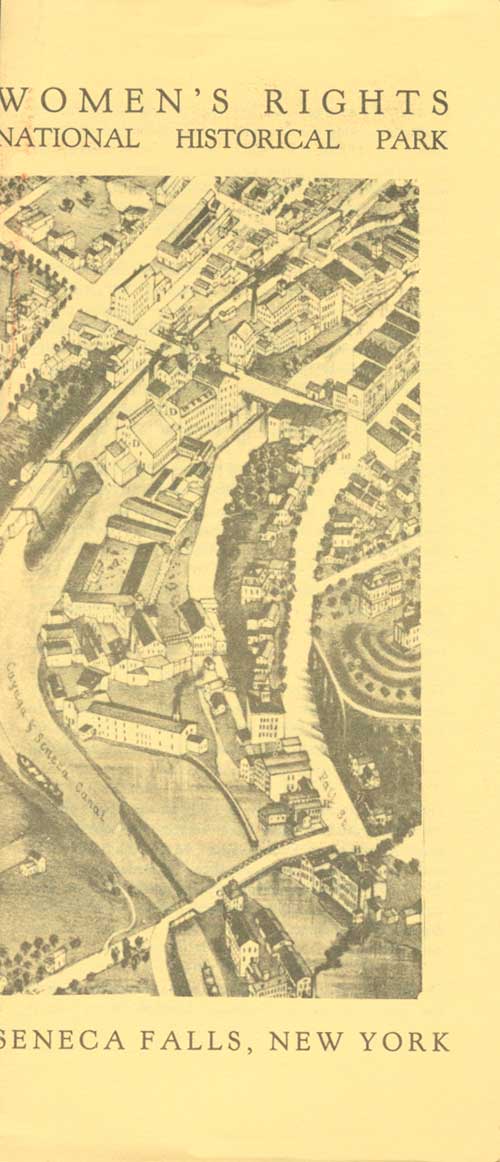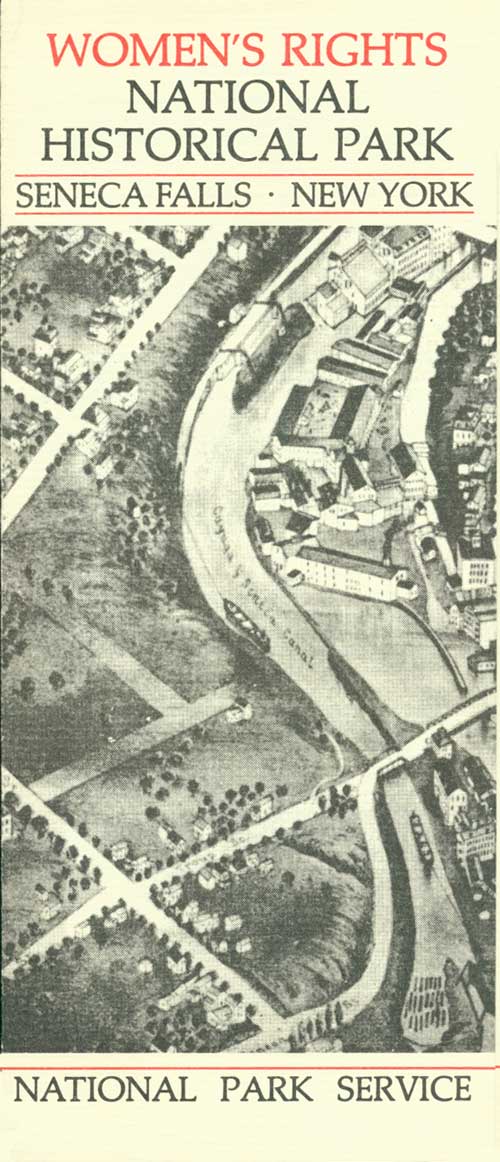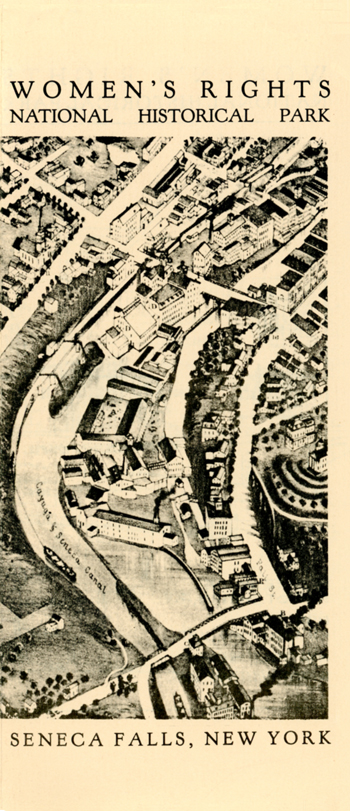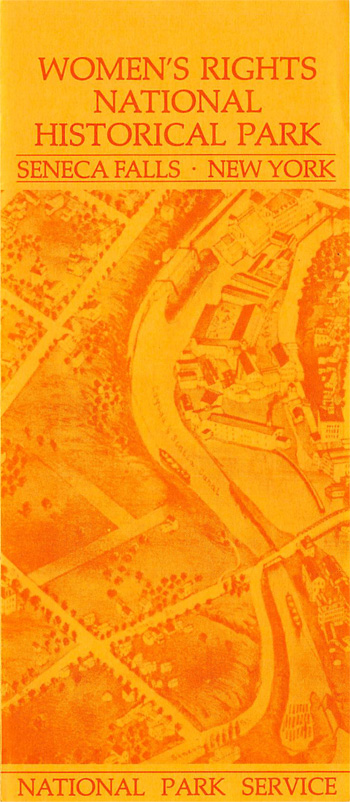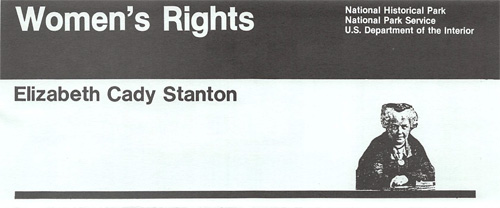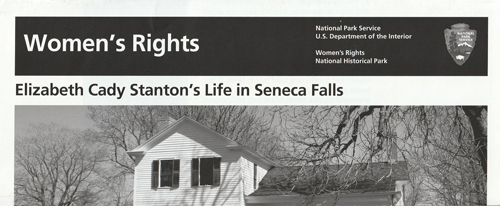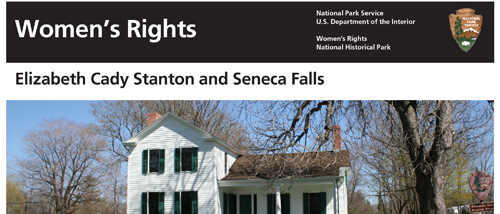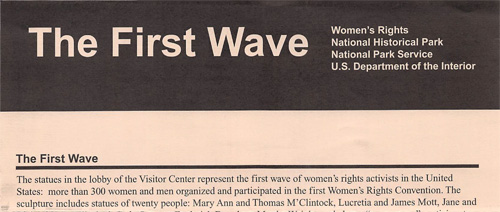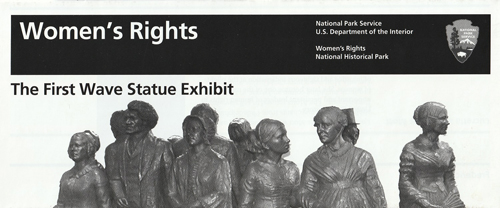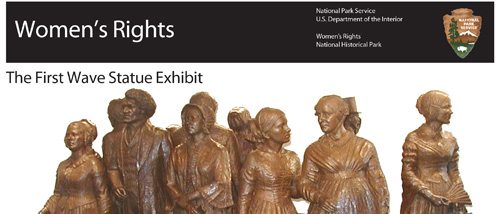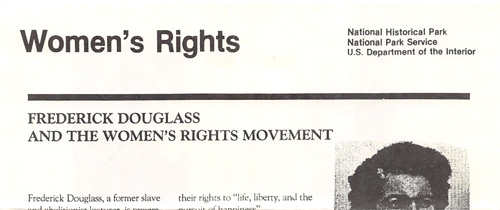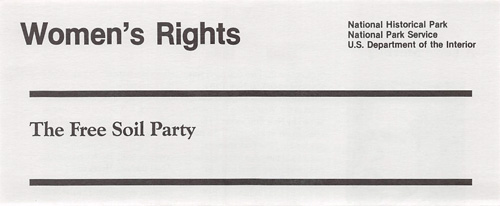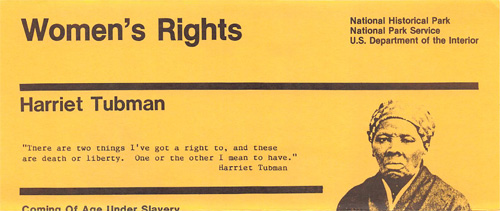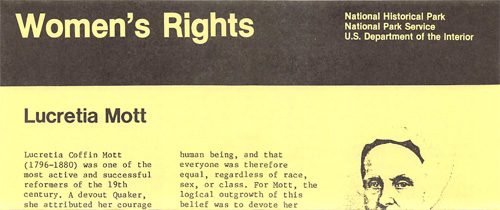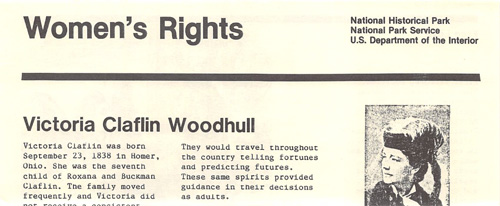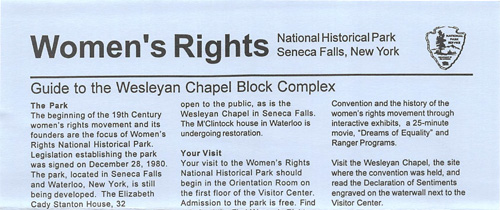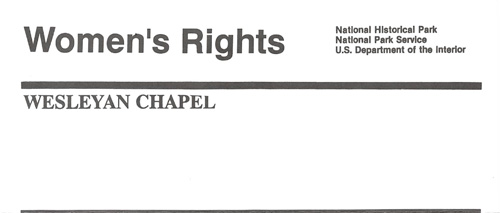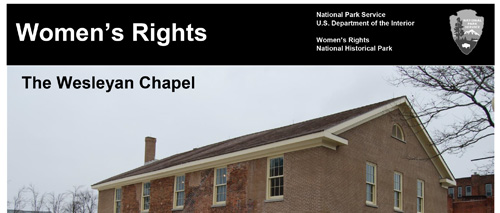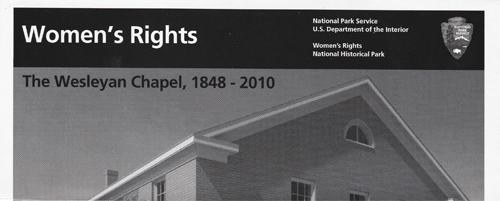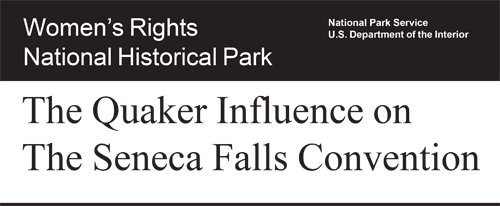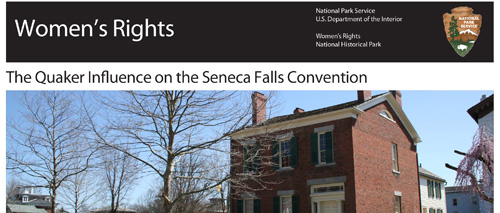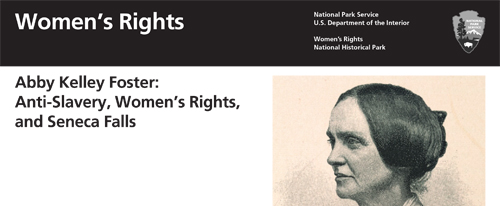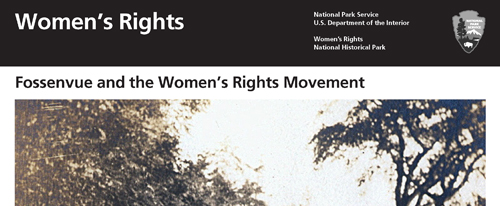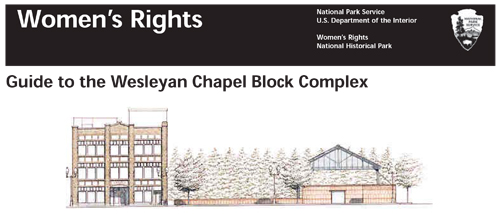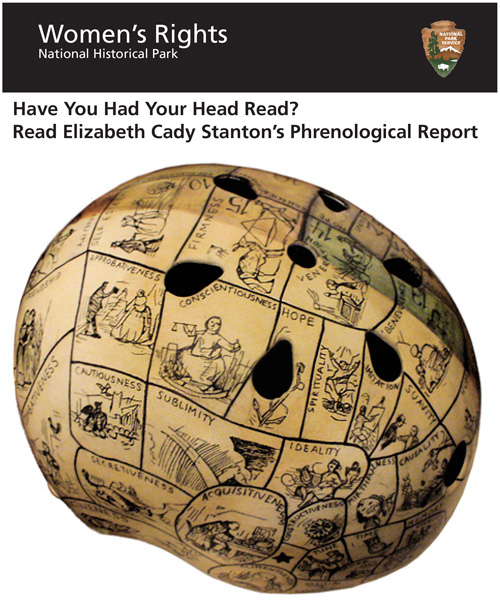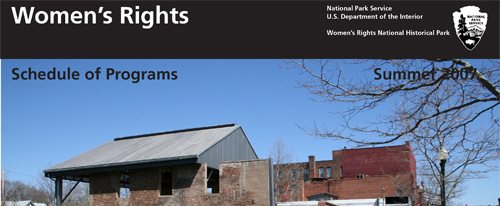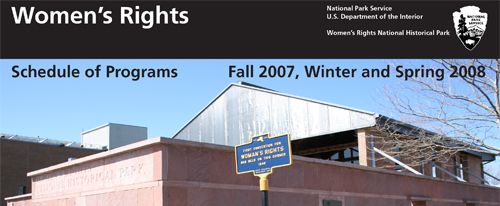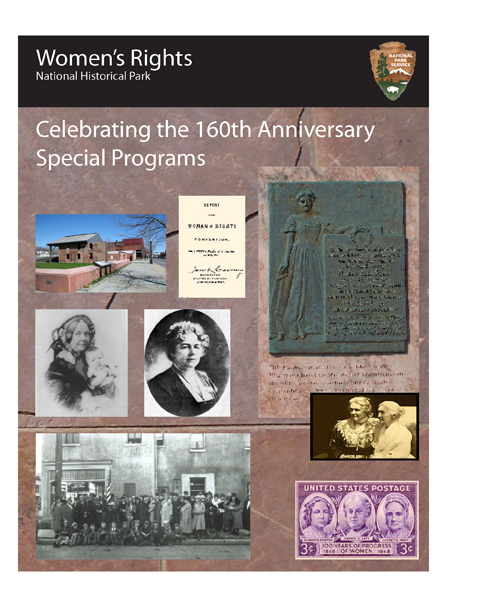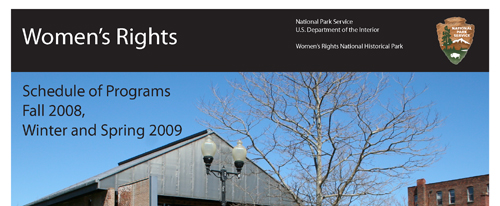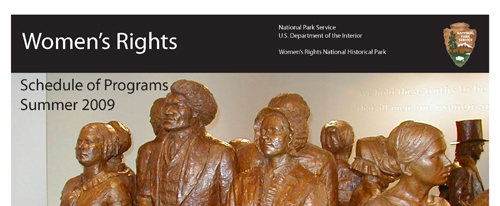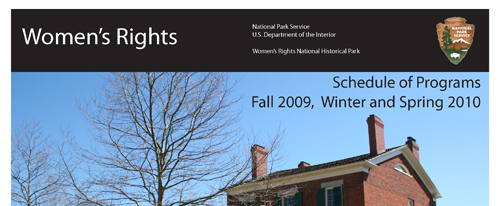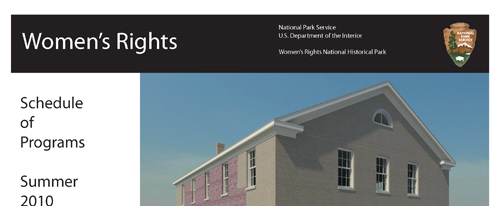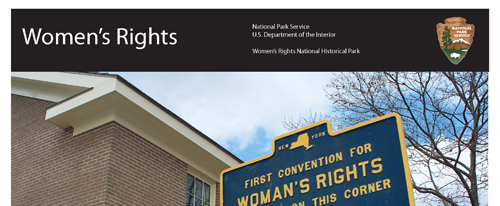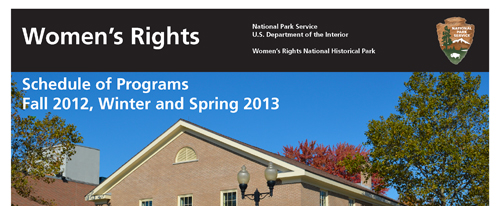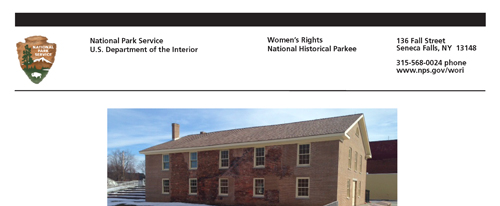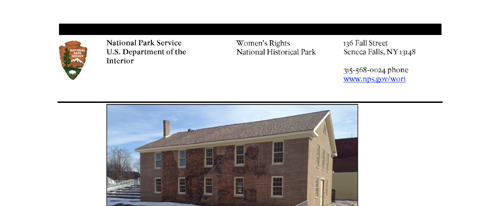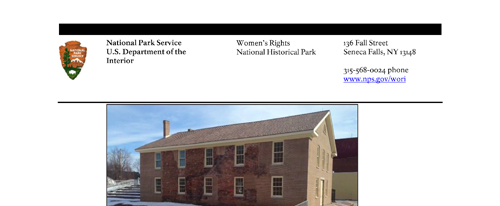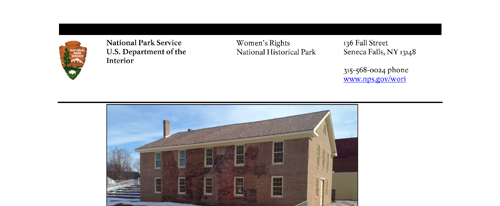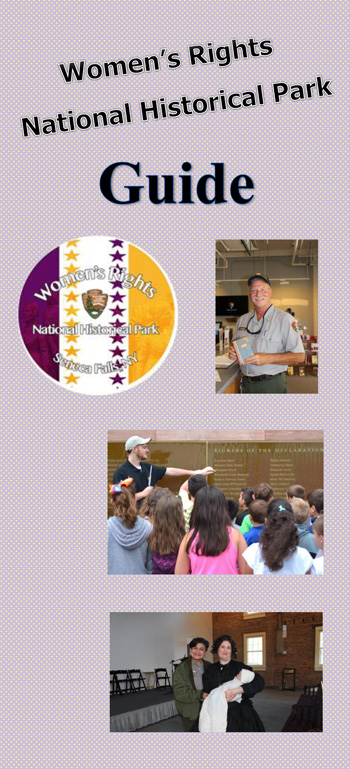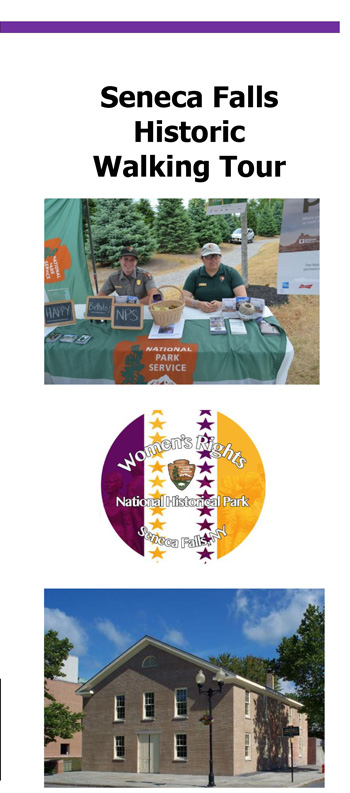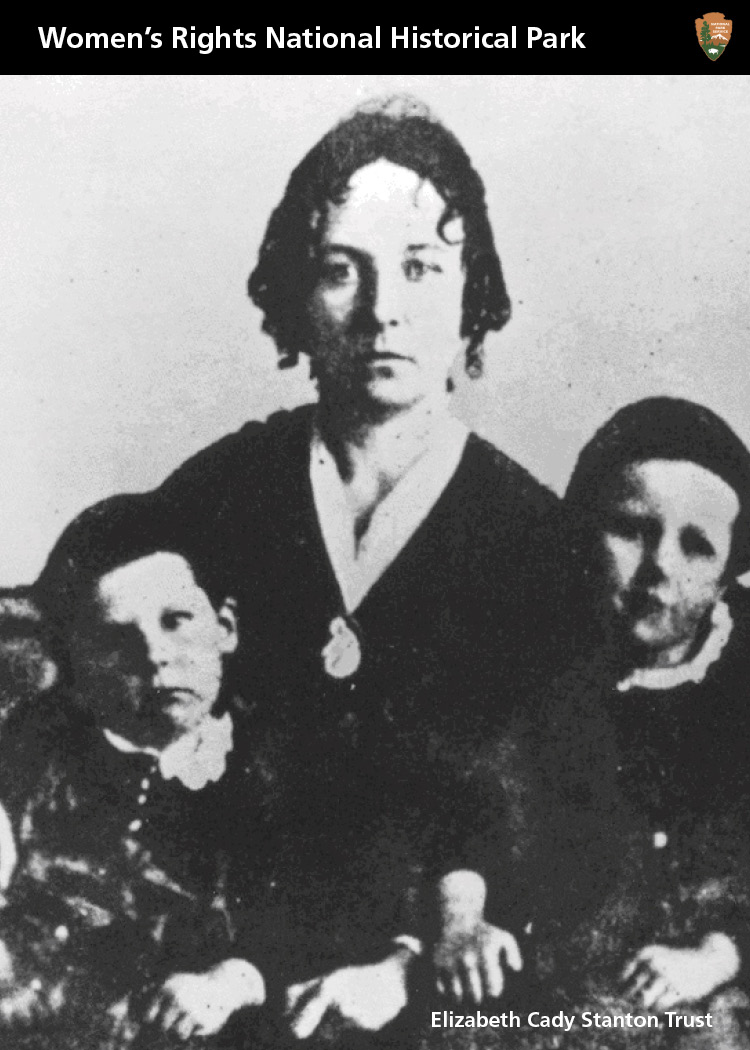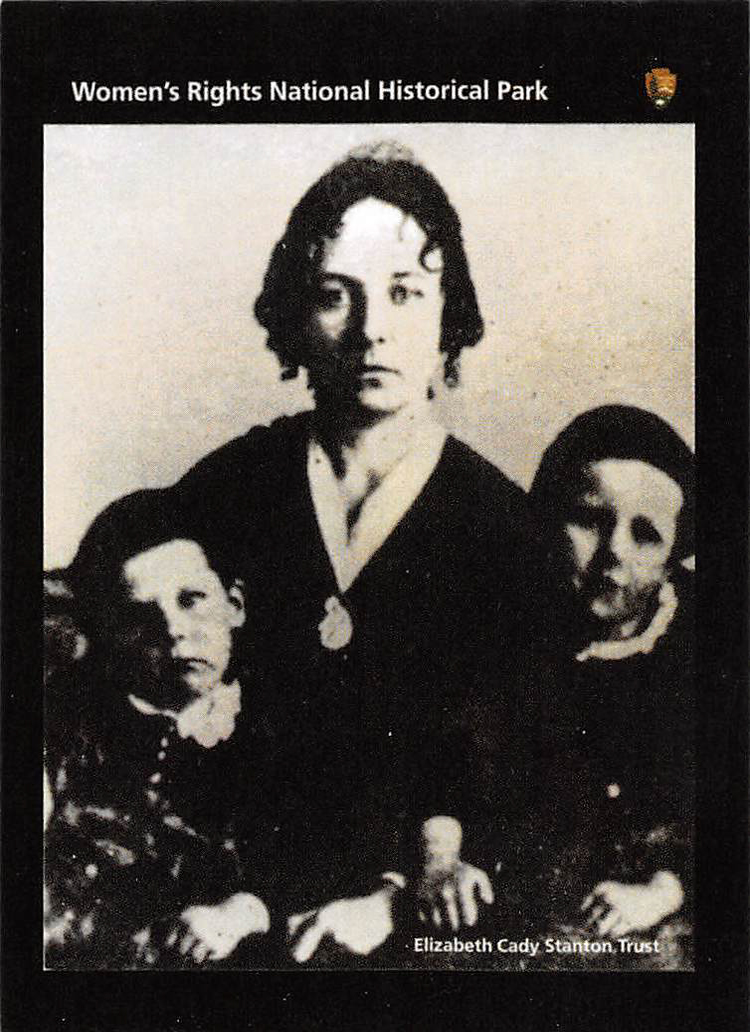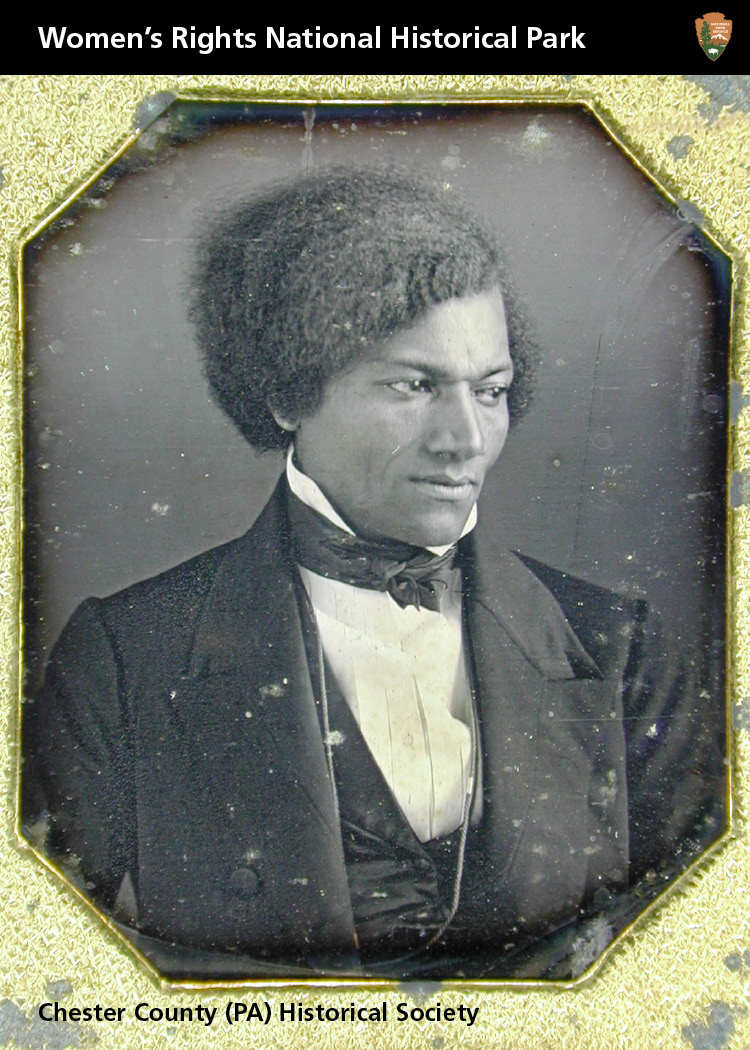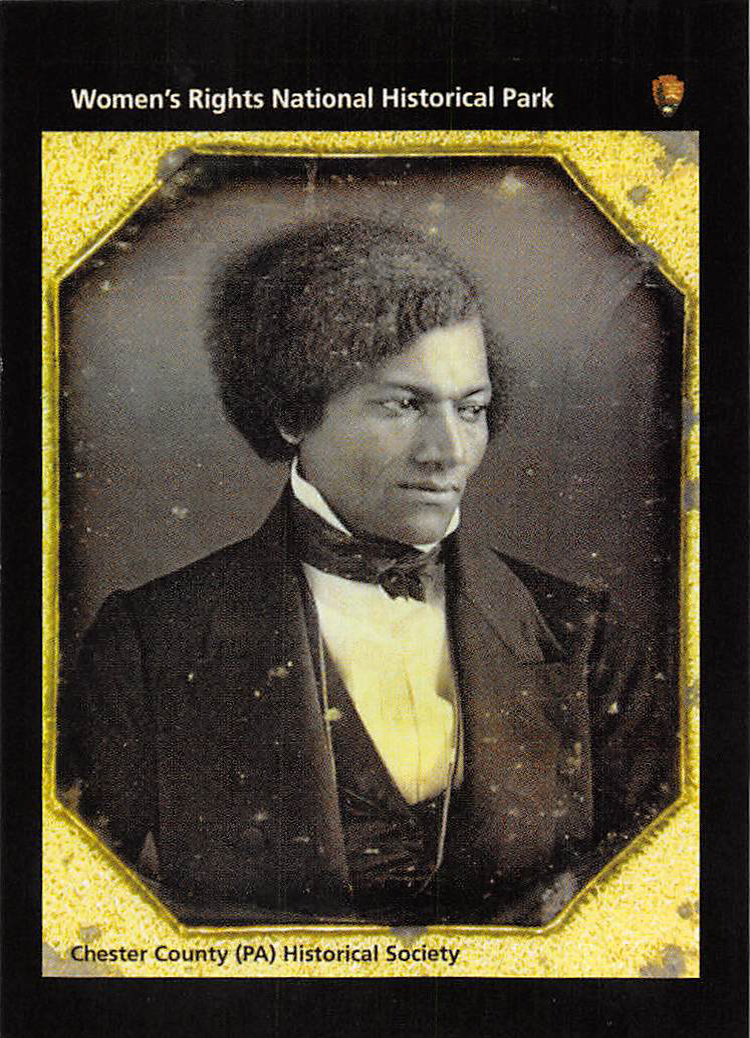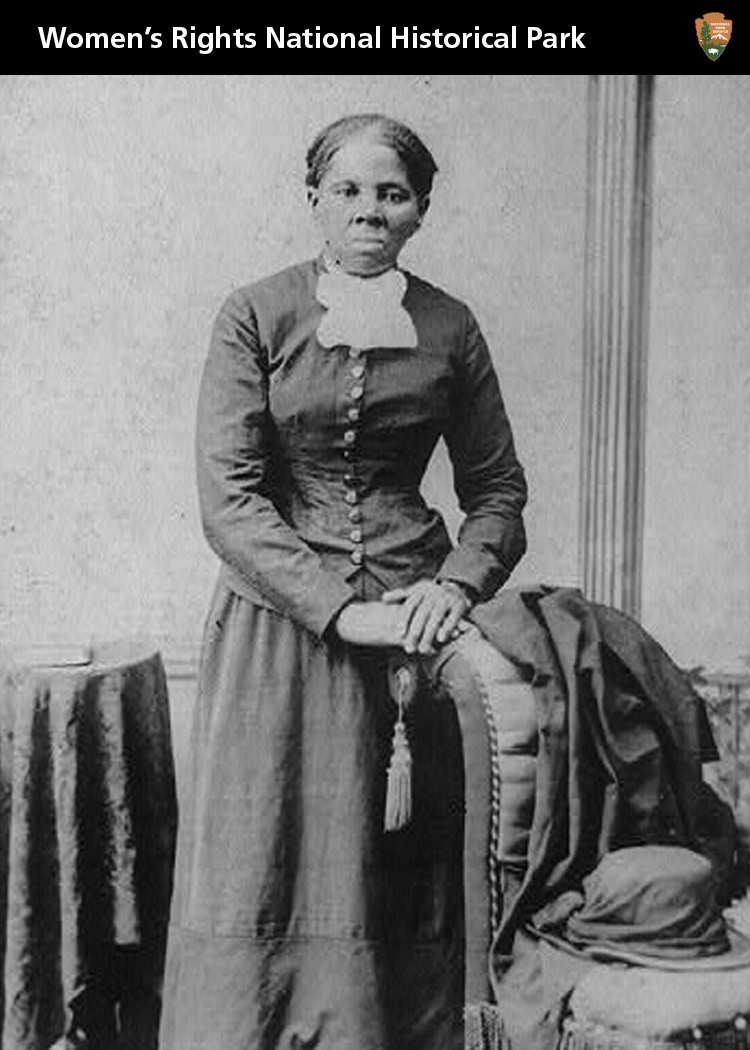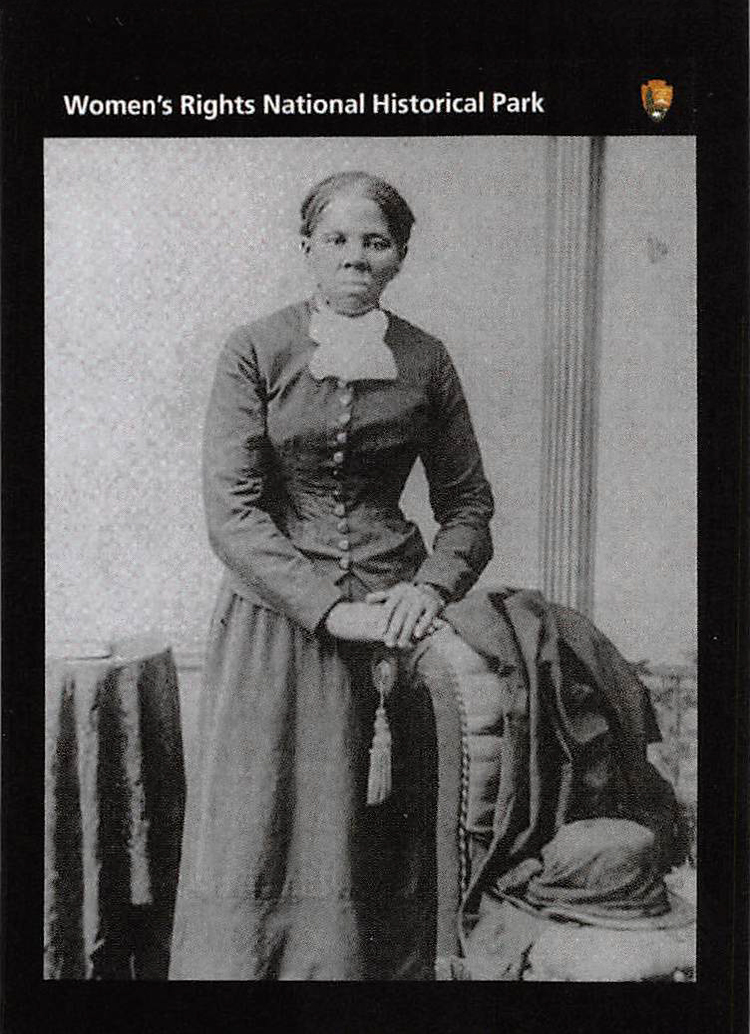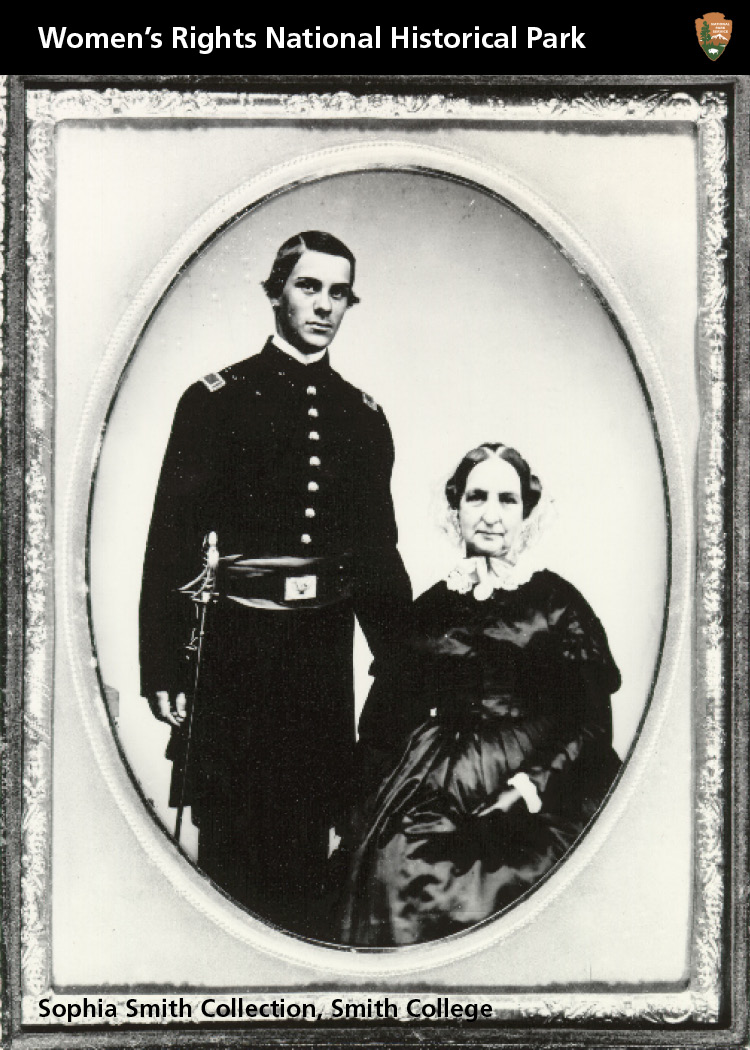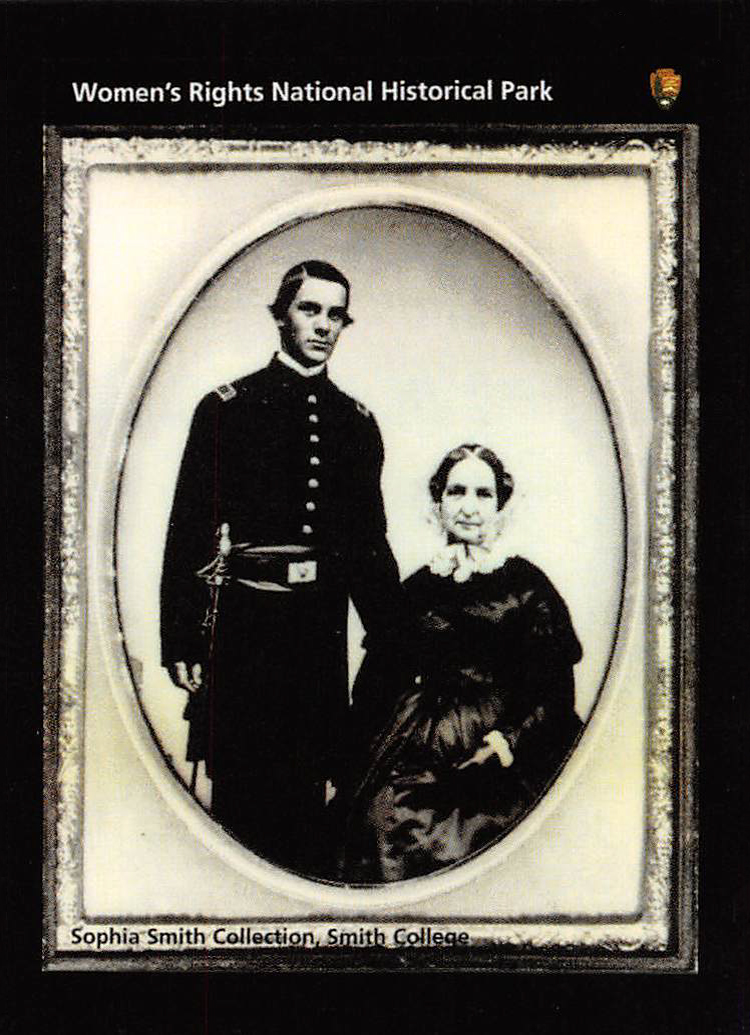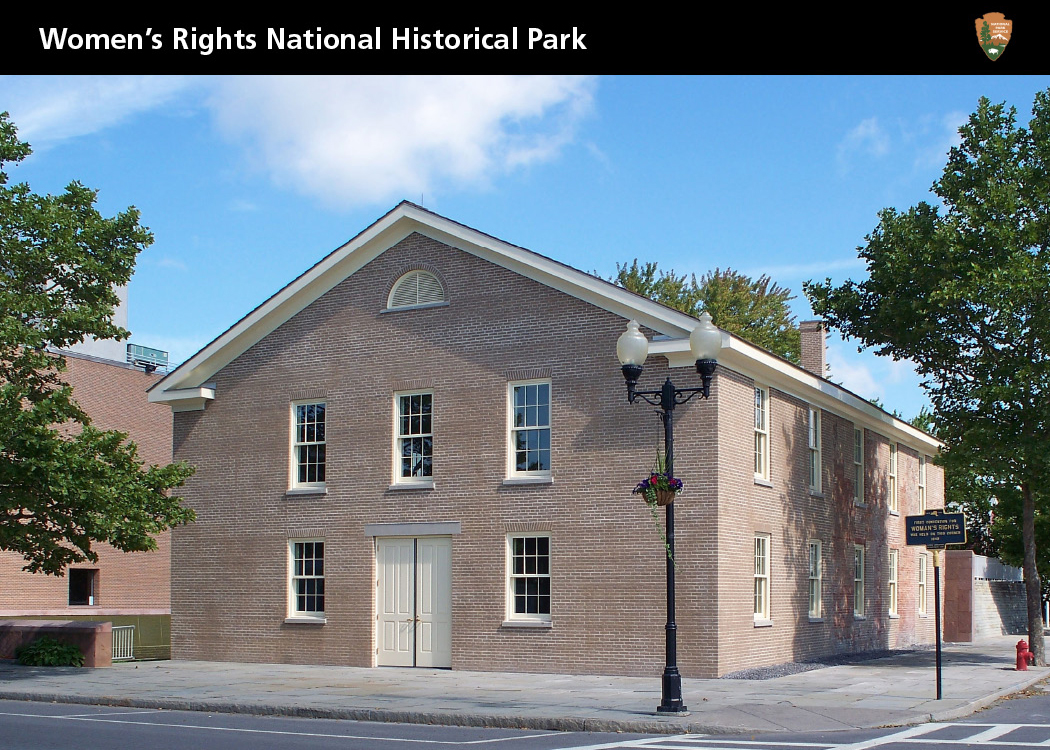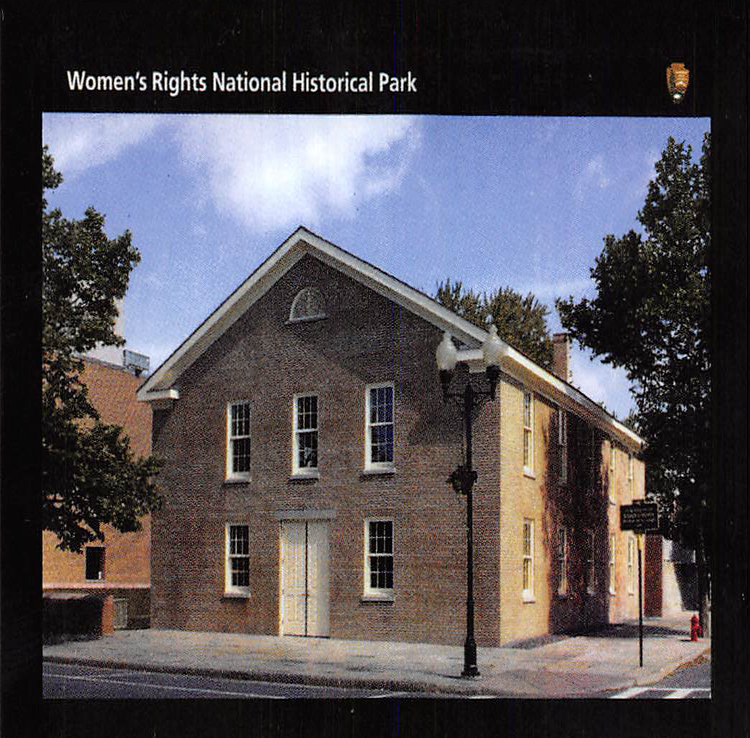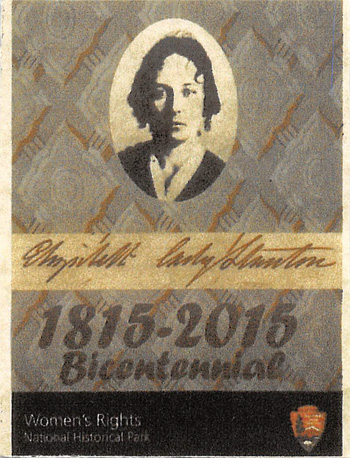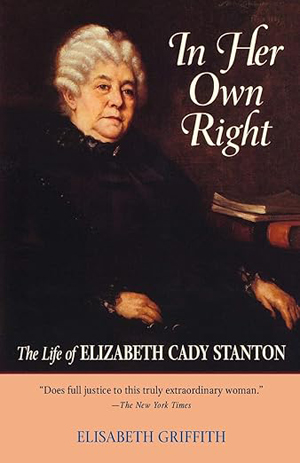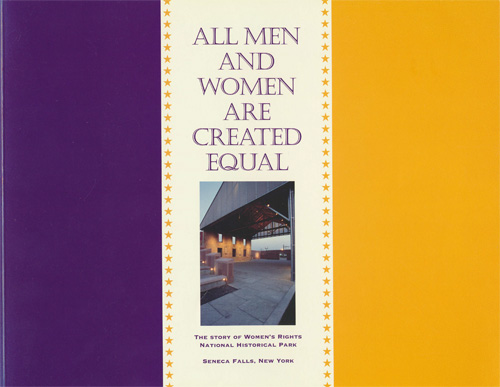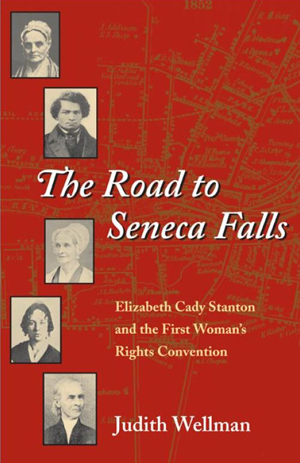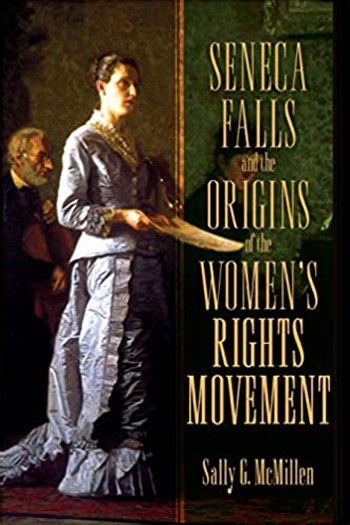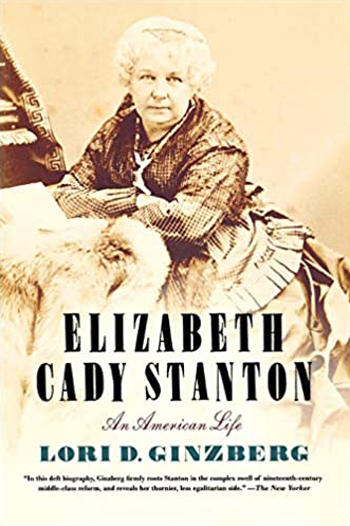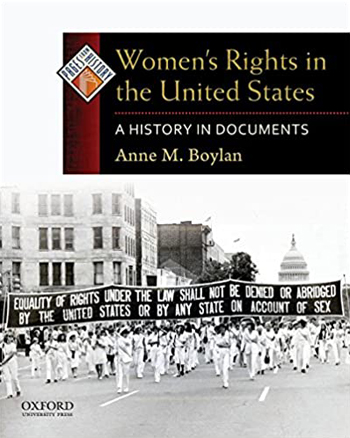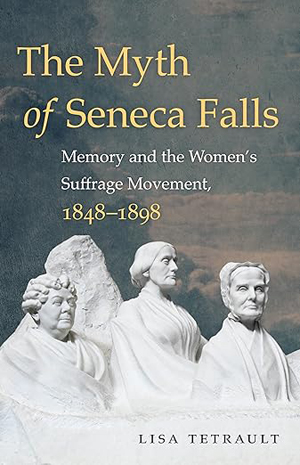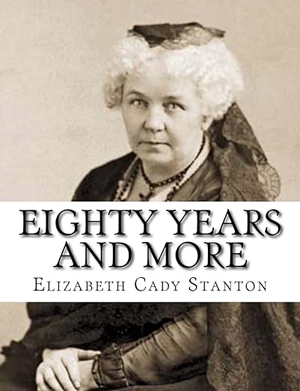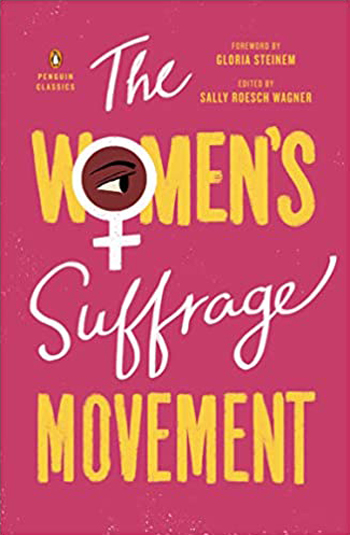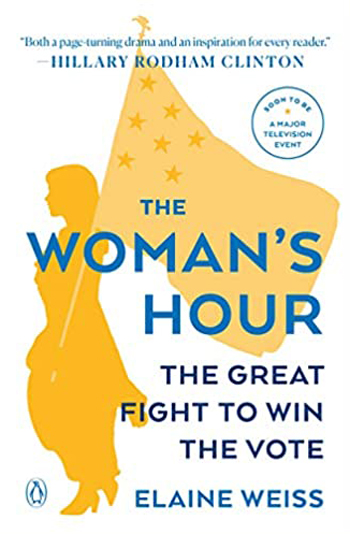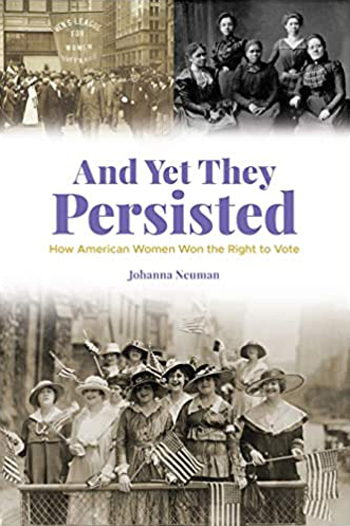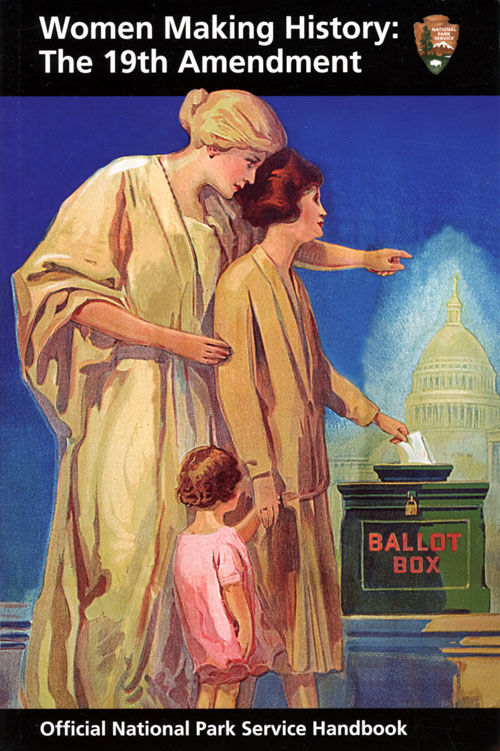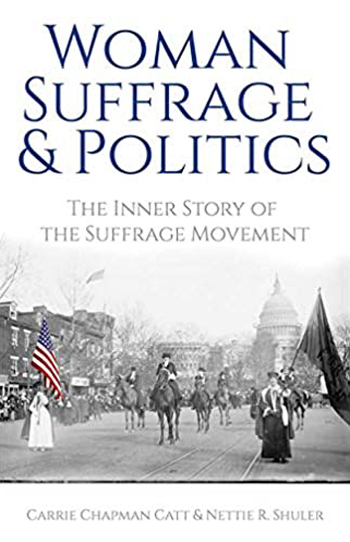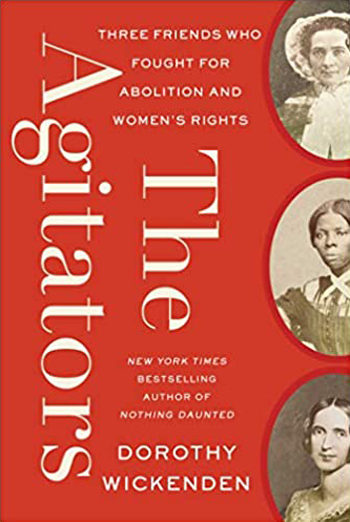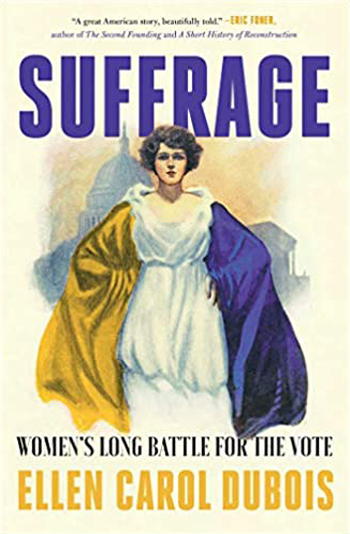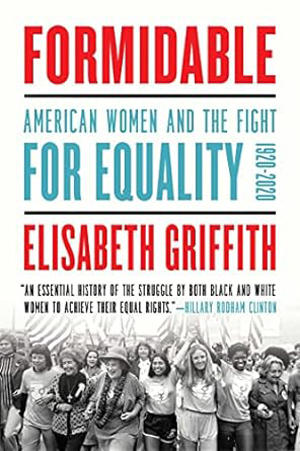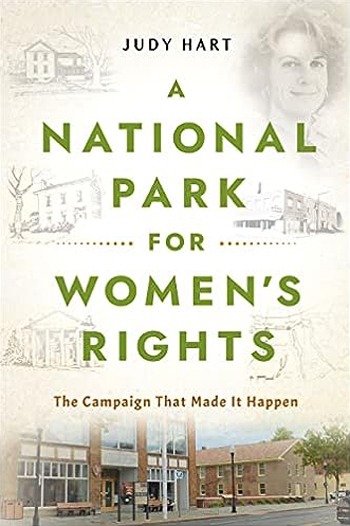|
Women's Rights National Historical Park New York |
 |
 NPS photo | |
"I was born and lived almost forty years in South Bristol, Ontario County—one of the most secluded spots in Western New York, but from the earliest dawn of reason I pined for that freedom of thought and action that was then denied to all womankind...But not until that meeting at Seneca Falls in 1848, of the pioneers in the cause, gave this feeling of unrest form and voice, did I take action."
—Emily Collins
For Emily Collins, who went on to start a local equal rights organization, and for other women of 1840s America, the news of a women's rights convention was a vivid reminder of their inferior status. By law or by custom an unmarried woman generally did not vote, speak in public, hold office, attend college, or earn a living other than as a teacher, seamstress, domestic, or mill worker. A married woman lived under these restrictions and more: she could not make contracts, sue in court, divorce an abusive husband, gain custody of her children, or own property, even the clothes she wore. Though middle-class wives reigned over the domestic sphere, legally their husbands controlled them. Individual women publicly expressed their desire for equality, but it was not until 1849 that a handful of reformers in Seneca Falls, N.Y., called "A Convention to discuss the social, civil, and religious condition and rights of Woman."
Why Seneca Falls? A significant reform community emerged in western New York in the 1830s and 1840s. Among these reformers were abolitionists who joined relatives and started businesses in Seneca Falls and Waterloo. Here and elsewhere, Quaker women like Philadelphian Lucretia Mott took an active role in the effort to end slavery. For Mott, her sister Martha Wright, Jane Hunt, Mary Ann M'Clintock, and 32-year-old Elizabeth Cady Stanton, the next logical step was to demand rights for women. In July 1848 they planned the convention and hammered out a formal list of grievances based on the Declaration of Independence, denouncing inequities in property rights, education, employment, religion, marriage and family, and suffrage. The demand for the "elective franchise" was so radical that even Mott protested, but Stanton had her way. On July 19 the Declaration of Sentiments was presented before an audience of about 300. "We hold these truths to be self-evident: that all men and women are created equal," announced Stanton at the First Women's Rights Convention.
The advocates expected controversy. True ladies, a Philadelphia newspaper wrote after the convention, would be foolish to sacrifice their status as "Wives, Belles, Virgins and Mothers" for equal rights. Many signers of the declaration removed their names. But 12 days later a second convention was held in Rochester. By 1900 armies of women marched for suffrage. Today many of the convention's most radical demands are taken for granted. The Declaration of Sentiments was the start; its words have a relevance that reaches far beyond that warm July day in Seneca Falls.
The organizers of the First Women's Rights Convention: Elizabeth Cady Stanton with daughter Harriot, Lucretia Mott, Martha Wright Mary Ann M'Clintock. and Jane Hunt.
After the convention, Hunt remained in Waterloo and continued to work with her husband at various reform efforts. The M'Clintocks moved to Philadelphia in 1856. Wright and two M'Clintock daughters became active suffragists. Mott, Stanton, and Wright with Lucy Stone, Abby Kelly Foster, and Susan B. Anthony, led the movement through its formative years.
Seneca Falls and Beyond
"What are we next to do?" asked Elizabeth Cady Stanton after the 1848 convention. The women of Seneca Falls had challenged America to social revolution with a list of demands that touched every aspect of life. Testing different approaches, the early women's rights leaders came gradually to view the ballot as the best way to change the system, but they did not limit their efforts to one issue. Fifty years after the convention, women could claim progress in property rights, employment and educational opportunities, divorce and child custody laws, and increased social freedoms. By the early 1900s, a coalition of suffragists, temperance groups, reform-minded politicians, and women's social welfare organizations mustered a successful push for the vote.
Although the ballot was never the primary agent of social reform, as many had hoped, the fight for suffrage expanded women's influence in the political arena. Again the question arose: What next? Immediately after 1920 many women worked for reform through groups such as the League of Women Voters and national political parties. Some women asserted their rights on a personal level by attending college, taking jobs, adopting new clothing fashions, and creating new national professional organizations. Then as now, each woman sought her own definition of freedom.
In 1848 the Seneca County Courier warned that the convention's resolutions were "of the kind called radical... Some will regard them with respect—others with disapprobation and contempt." The story of the women's movement is the story of ideas once controversial, now unremarkable. The chronology below outlines the major events that changed the status quo for women in America. Which of our present efforts will contribute toward a future of equality? What are we next to do?
"If particular care and attention is not paid to the ladies," writes Abigail Adams in 1776, "we are determined to foment a rebellion, and will not hold ourselves bound by any laws in which we have no voice or representation."
"Remember the Ladies"
1775 American Revolution begins. Abigail Adams in 1776 admonishes husband John and other Revolutionary leaders to "remember the ladies" in the formation of the new government.
1784 Judith Sargent Murray writes essays endorsing women's education. Murray's "On the Equality of the Sexes" appears in Massachusetts Magazine in 1790.
1788 U.S. Constitution is ratified. With decisions about voting qualifications left up to states. New Jersey women property owners have full franchise until 1807. Elsewhere women are able to vote in local elections.
Early 1800s Popular literature defines a new middle-class ideal: women dominate the "sphere" of home and family, with men viewed as leaders in politics and business.
1830s American Anti-Slavery Society is founded in Philadelphia in 1833 by Quakers seeking immediate emancipation of slaves. AASS's 1,600 auxiliaries gather over 400,000 signatures on antislavery petitions by 1838.
As abolition cause escalates, lecturers like Sarah and Angelina Grimké promote women's concerns simultaneously with abolition. Sarah draws criticism for her 1837 Letters on the Equality of the Sexes. AASS splits in 1839 over issue of women's rights.
1840 Newlyweds Henry and Elizabeth Cady Stanton attend World Anti-Slavery Convention in London, where organizers refuse to seat women delegates. Elizabeth Cady Stanton and Lucretia Mott resolve to hold a convention devoted to women's rights.
Lucy Stone champions reform both in her public life, by leading abolition and women's suffrage efforts, and in her private life by keeping her maiden name after marrying. "We hold women to be justly entitled to all we claim for man," writes Frederick Douglass soon after the 1848 convention. Two decades later Douglass breaks with Stanton over strategy.
A Call to Convention
1848 Elizabeth Cady Stanton and Quaker abolitionists Jane Hunt, Mary Ann M'Clintock, Lucretia Mott, and Martha Wright hold First Women's Rights convention; demand full and equal rights with men.
1850 Boston women abolitionists, including Lucy Stone, organize national women's rights convention in Worcester, Mass.; over 1,000 people attend. Subsequent state and national conventions are held throughout the 1850s.
1851 Stanton meets Quaker teacher Susan B. Anthony in Seneca Falls. They form an activist team and use temperance and abolition gatherings to address women's issues. Stanton writes speeches and devises strategy, while Anthony lectures and circulates petitions.
War and Reconstruction
1860 Stanton and Anthony work successfully to amend Married Women's Property Act of New York, originally enacted in 1848. Revised law allows wives to hold property, keep earnings and inheritances, make contracts, sue in court, and share child custody.
1861-65 Northern and Southern women take over jobs on farms and in factories, businesses, and government offices during Civil War. Thousands of women work as nurses, opening profession to females.
1862 Morrill Act grants federal land to support coeducational colleges and universities in the West. Homestead Act grants free land to any "head of household," including women. New York 1860 law repealed.
1863 After Emancipation Proclamation frees many slaves in Confederacy, Stanton and Anthony's National Women's Loyal League presents 400,000 signatures on petition to Congress for a complete end to slavery. Mott and contemporaries yield leadership to rising generation; new women's leaders anticipate that postwar expansion of civil rights will include female suffrage. Thirteenth Amendment outlaws slavery in 1865.
1867 First statewide women's suffrage campaigns in Kansas and New York are defeated.
1869 Suffragists split over strategy after 14th Amendment specifies voting rights for "male citizens." Stanton and Anthony form National Woman Suffrage Association (NWSA), which pushes for a women's suffrage amendment. Lucy Stone, Julia Ward Howe, and others organize American Woman Suffrage Association (AWSA) to support voting rights first for black males, then women. Wyoming becomes first U.S. territory to enact women's suffrage.
"It has been said," writes Stanton of Susan B. Anthony, "that I forged the thunderbolts and she fired them." Beginning in 1868 they publish the short-lived Revolution, advocating "Equal Pay," "Cold Water not Alcoholic Drinks," and "a new Commercial and Financial Policy."
"Revolution"
1872 Anthony and colleagues test 14th and 15th amendments by casting votes in New York. Suffragists are arrested and fined. An 1875 U.S. Supreme Court ruling upholds states' right to deny women the vote. In 1876 Anthony and others crash U.S. Centennial celebration in Philadelphia's Independence Hall, demanding women's vote.
Temperance societies, first popular in the 1830s, were among the earliest American women's groups. The crusade made women all the more aware of their legal defenselessness against a drunken husband and the need for property and divorce rights. After the Civil War the movement reemerged, its leaders promoting female suffrage as a means of social reform.
Social Reform Movements
1877 Backed by the NWSA, a women's suffrage amendment is first introduced in Congress but not voted on for 10 more years. As Reconstruction era draws to a close. Southern blacks see erosion of their new civil rights.
1879 Frances Willard becomes president of Woman's Christian Temperance Union (WCTU), established in 1874 to fight alcohol-related social ills. Willard strongly advocates women's suffrage as a means to impose a moral influence on society. WCTU becomes nation's largest women's organization by the 1880s.
1881 Knights of Labor organizes housewives, domestics, factory workers, railroad workers; 65,000 women join. Knights disband by 1886 after losing national strike. Women's organized labor recovers by the early 1900s to become an active force in suffragism.
1887 WCTU and suffragists present U.S. Senate with petition of 200,000 signatures supporting suffrage amendment. Amendment is defeated.
1889 Jane Addams and Ellen Starr establish Hull House in Chicago, nation's first settlement house. In following decades an army of educated female reformers, from young single women to wives, mothers, and grandmothers, investigates labor conditions, starts settlement houses, promotes education and public health, agitates for liberalized birth control laws, and marches for suffrage. Increasingly, women activists see vote as a means to improve society.
1890 Wyoming is admitted as first women's suffrage state. Colorado and Idaho follow; campaigns in these states are led by Carrie Chapman Catt. Utah enacts women's suffrage in 1896 to ensure Mormon control of government. NWSA and AWSA merge into the National American Woman Suffrage Association (NAWSA). Stanton is president, succeeded by Anthony in 1892. Frances Willard sits on executive board. NAWSA strategy shifts from constitutional amendment to state referenda.
1902 Elizabeth Cady Stanton dies at age 86. Four years later Susan B. Anthony dies at 85. New generation of suffragists are solidly in power, arguing for vote on basis of female moral superiority rather than equality. NAWSA is led by Anna Howard Shaw and Carrie Chapman Catt.
Antisuffragist arguments are based mainly on differences between the sexes, while pro-suffrage groups claim that such differences make women better qualified voters. Some antisuffrage groups are exposed as fronts for liquor interests.
The Suffrage Bandwagon
1910 Washington becomes first state in 20th century to extend full franchise to women, inspiring nationwide campaign that soon brings success in several western states. Progressive Party endorses women's suffrage in 1912. Stanton's daughter Harriot Stanton Blatch organizes first suffrage parades in New York City; solicits working women's support through Women's Trade Union League.
1911 Jane Addams, now vice-president of NAWSA, advocates immigrant women's right to suffrage, countering belief by some that vote belongs to native-born, white, educated citizens.
1913 Alice Paul and newest generation of suffragists revive demand for constitutional amendment. Paul, who worked in England with militant suffragist Emmeline Pankhurst, introduces mass demonstrations, hunger strikes, and constant pressure on political party in power. Paul and several thousand marchers protest Woodrow Wilson's inauguration in March 1913. Paul and others leave NAWSA and form National Women's Party in 1916.
1916 Margaret Sanger and her sister Ethel Byrne open first American birth control clinic in New York City.
1917 U.S. enters World War I. Women take over jobs for men serving in armed forces. Women's Bureau is formed; for next several decades it is the only federal agency dealing with women's concerns.
The 19th Amendment
1918 Women's suffrage amendment is reintroduced by Jeanette Rankin (R-Montana), first woman elected to the U.S. Congress; passes both houses by 1919.
1920 19th Amendment is ratified. Nicknamed the Susan B. Anthony Amendment, it states that "The right of citizens of the United States to vote shall not be denied or abridged by the United States or by any State on account of sex." National American Woman Suffrage Association becomes League of Women Voters, advocates social reforms and protective laws for working women. National Women's Party opposes protective laws and promotes full social equality.
1923 At the 75th anniversary of the Seneca Falls convention, Alice Paul proposes an Equal Rights Amendment to remedy inequalities that were not addressed in the 19th Amendment.
Late 1920s Many states continue to bar women from jury duty and public office. Widows succeed their husbands as governors of Texas and Wyoming. Middle-class women attend college and enter labor force. Anticipated "women's vote" fails to materialize by end of decade.
1933 Frances Perkins is appointed by President Franklin D. Roosevelt as first female Secretary of Labor. In the New Deal years, at urging of First Lady Eleanor Roosevelt and Democratic women's leader Molly Dewson, women gain positions in federal social service bureaus. Mary McLeod Bethune is director of the Negro Affairs Division of the National Youth Administration.
A New Deal
1936 Federal court rules birth control legal for its own sake, rather than solely for prevention of disease.
1941 United States enters World War II. Millions of women are recruited for defense industry jobs in war years and become significant part of labor force. WAC and WAVE established as first women's military corps.
1947 Many women leave labor force to get married and make way for returning soldiers. By end of decade, numbers of working women are again on the increase.
1952 Democratic and Republican parties eliminate women's divisions.
"The Feminine Mystique"
1955 Civil Rights movement escalates in the South; Septima Clark and others lead sit-ins and demonstrations, providing strategies for future protests.
1960 FDA approves birth control pills.
1961 President's Commission on the Status of Women is established, headed by Eleanor Roosevelt. Commission successfully pushes for passage in 1963 of Equal Pay Act, first federal law to require equal compensation for men and women in federal jobs.
1963 Betty Friedan's The Feminine Mystique articulates dissatisfaction with limitations on women.
1964 Civil Rights Act prohibits job discrimination on the basis of race or sex and establishes Equal Employment Opportunity Commission to address discrimination claims.
1966 National Organization for Women, founded by Betty Friedan and others, promotes child care for working mothers, abortion rights, the Equal Rights Amendment, and "full participation in the mainstream of American society now."
1972 Equal Rights Amendment passes both houses and is signed by President Richard Nixon. Civil Rights Act bans sex discrimination in employment and education. Shirley Chisholm is first African American to run for president.
1973 In Roe v. Wade, U.S. Supreme Court affirms right to first trimester abortions without state intervention.
1974 Ella Grasso of Connecticut is first woman governor elected in her own right.
1980 Women's Rights National Historical Park is established Dec. 28.
1981 Sandra Day O'Connor is appointed first woman U.S. Supreme Court justice.
1982 Deadline for ERA ratification expires; final count is three states short of adoption.
1984 Geraldine Ferraro is first woman from a major political party nominated as vice president.
1992 More women run for and are elected to public office than in any previous year in U.S. history.
Today The fight for equality is waged on many fronts: women are seeking political influence, better education, health reform, job equity, and legal reform. The demands echo those of the movement throughout its history. In 1848 Stanton, Mott, and others claimed on behalf of American women "all the rights and privileges which belong to them as citizens." What would the reformers from Seneca Falls do today to contribute toward a future of equality? What will you do?
Planning Your Visit
The setting for the First Women's Rights Convention and the homes of some participants are preserved as Women's Rights National Historical Park, estabished by Congress in 1980.
Begin at the visitor center, 136 Fall Street, open daily except fall and winter federal holidays. Hours are 9 am to 5 pm. The visitor center has exhibits, a film, and a list of activities. The center is accessible for visitors with disabilities; ask staff about access to the other sites.
Declaration Park features a granite water wall engraved with the Declaration of Sentiments. The remains of the Wesleyan Chapel are preserved. The restored Elizabeth Cady Stanton House in Seneca Falls and the M'Clintock House in Waterloo are open to the public. The Hunt House in Waterloo is closed for restoration.
Guided tours of the Stanton house are available in summer and on a limited basis at other times. Restoration tours of the Hunt House are available periodically.
The M'Clintock House was owned by the Hunts, who rented it to relatives and fellow Quaker abolitionists Mary Ann and Thomas M'Clintock. Convention planners met here on July 16, 1848, to draft the Declaration of Sentiments.
The Hunt House was the home of Jane and Richard Hunt, Quakers active in the Waterloo reform community. Their mansion was the gathering place for Stanton, Mott, Wright, M'Clintock, and Jane Hunt as they planned the convention on July 9.
The Elizabeth Cady Stanton House was the family's home for 15 years. Stanton's philosophy was based in large part on her experiences as a Seneca Falls housewife. She was 31 years old when she moved here in 1847 with her husband, a lawyer and abolitionist lecturer, and three boys. Stanton found small-town life oppressive: "My duties were too numerous and varied and none sufficiently exhilarating or intellectual to bring into play my higher faculties. I suffered with mental hunger, which, like an empty stomach, is very depressing." Accustomed to the activity of Boston reform circles, Stanton drew inspiration from the company of Lucretia Mott and her associates.
Stanton defied many of the day's housekeeping and child-rearing customs. For many years she wore an outfit consisting of pants and a knee-length skirt, popularized by Amelia Bloomer, which allowed freedom of movement.
She encouraged her seven children to join parlor discussions with visitors like the Motts and Frederick Douglass. For many years Stanton hosted a "conversation club" where young men and women discussed issues of the day and socialized. Her benevolent work with the town's poor made her all the more aware of the economic insecurity of women.
 (click for larger map) |
On July 19 and 20, 1848, about 300 women and men gathered in the Wesleyan Chapel to hear the first formal demands for women's rights. Curious local residents joined abolitionists, temperance workers, and reformers to fill the chapel. On the first day participants debated the wording of the Declaration of Sentiments. The Seneca County Courier reported that "an intelligent and respectful audience" attended the public session that evening to hear the "eminently beautiful and instructive" discourse of Lucretia Mott. At the next day's session the amended declaration was adopted; 100 women and men signed the document. Frederick Douglass reiterated his support at the final session.
Location
From I-90 (New York State Thruway) take exit 41; go south on NY. 414; go
east on U.S. 20, (becomes Fall St,); follow signs to the visitor center.
Airports within one hour's drive include Syracuse, Rochester, and
Ithaca. An entrance fee is charged.
Source: NPS Brochure (2008)
|
Establishment Women's Rights National Historical Park — December 28, 1980 |
For More Information Please Visit The  OFFICIAL NPS WEBSITE |
Brochures ◆ Site Bulletins ◆ Trading Cards

Documents
A Half Century of Struggle: Gaining Woman Suffrage in Kansas (Wilda M. Smith, extract from Kansas History: The Journal of the Central Plains, Vol. 4 No. 2, Summer 1981)
A Vision Realized: Women's Rights National Historical Park Design Competition (Judy Hart, ed., 1991)
"All Men and Women are Created Equal:" An Administrative History of Women's Rights National Historical Park (Rebecca Conard, April 2012)
Amendment to the General Management Plan of 1986, Women's Rights National Historical Park (January 1991)
Commemorating the Suffrage Centennial in Seneca Falls, New York (2020)
Cultural Landscape Inventory: M'Clintock House, Women's Rights National Historical Park (Jodi Gee, January 1996)
Cultural Landscapes Inventory: Hunt House, Women's Rights National Historical Park (2000)
Cultural Landscapes Inventory: Stanton House, Women's Rights National Historical Park (1998, rev. 2004)
Economic Impacts of Women's Rights National Historical Park on Seneca County (Daniel J. Stynes, June 2000)
Elizabeth Cady Stanton: The Road to Seneca Falls (Rebecca Billman, extract from Perspectives in History, Vol. XVI, 2000-2001, ©Northern Kentucky University)
Ethnographic Overview and Assessment, Women's Rights National Historical Park (Heather Lee Miller, Emily Greenwald and Dawn Vogel, July 3, 2009)
Feasibility Study: Study Report — Women's Rights National Historic Trail (2002)
Foundation Document, Women's Rights National Historical Park, New York (December 2014)
Foundation Document Overview, Women's Rights National Historical Park, New York (December 2014)
General Management Plan/Environmental Assessment: Women's Rights National Historical Park, New York Draft (June 1985)
Historic Furnishings Report: McClintock House/Stanton House, First Wesleyan Methodist Church, Women's Rights National Historical Park, New York (Carol Petravage, 1989)
Historic Grounds Analysis: Elizabeth Cady Stanton Homestead, Women's Rights National Historical Park (William A. Patterson, III, Nancy Gordon and Petrus Veneman, October 1986)
Historic Structure Report: Hunt House, Women's Rights National Historic Park, Seneca Falls and Waterloo, New York (Barbara A. Yocum and Vivien E. Rose, 2015)
Historic Structure Report: M'Clintock House, Women's Rights National Historic Park, Waterloo, New York (Barbara A. Yocum, 1993)
Historic Structure Report: Stanton House, Women's Rights National Historic Park (Barbara A. (Pearson) Yocum, written 1989, published 1998)
Historic Structure Report: Village Hall, Women's Rights National Historic Park, Seneca Falls, New York (Stacey A. Matson, Barbara A. Yocum, Maureen K. Phillips and Terry L. Wong, 1988)
Historic Structure Report: Wesleyan Chapel, Women's Rights National Historic Park, Seneca Falls, New York (Barbara A. Yocum and Terry L. Wong, Written 1988, Published 1992)
Historic Structure Report/Historical Data Section: Wesleyan Chapel (Sharon A. Brown, April 1987)
Interpretive Prospectus, Women's Rights National Historical Park (August 1988)
Junior Ranger, Women's Rights National Historical Park (Date Unknown; for reference purposes only)
National Register of Historic Places Nomination Forms
Elizabeth Cady Stanton House (c1983)
Fourth Ward School (Nancy Todd and Mary Williams Neustadter, February 1986)
Women's Rights Historic Sites (Thematic Resources) (Hanns Kuttner and Anne Ackerson, February 1980)
New York Building-Structure Inventory Forms
Amelia Bloomer House (Anne Ackerson, August 1978)
Elizabeth Cady Stanton Home (A.B. Covell, February 1980)
Hunt House (Anne Ackerson, August 1978)
Newsletter (The Center of the Rebellion): Vol. 1 No. 1, Winter 2012 • Vol. 1 No. 2, Spring 2012 • Vol. 1 No. 3, Summer 2012 • Vol. 1 No. 4, Fall 2012 • Vol. 2 No. 1, Winter 2013 • Vol. 2 No. 2, Spring 2013
Report of the Woman's Rights Convention (Seneca Falls, July 19-20, 1848)
Special History Study: Women's Rights National Historical Park (HTML edition) (Sandra S. Weber, September 1985)
Special Resource Reconnaissance Study: Susan B. Anthony House (September 2001)
Study of Alternatives, Women's Rights Historic Sites, New York (October 1979)
Summary of Architectural Data: The Wesleyan Chapel, Women's Rights National Historical Park, Seneca Falls, New York (Sharon K. Ofenstein and Barbara A. Yocum, 1987)
Women Making History: The 19th Amendment Official National Park Service Handbook (Tamara Gaskell, ed., 2020, ©Eastern National)
Women's History Sites: The Other Half of the American Story (Women's Progress Commemorative Commission, July 2001)
Women's Progress Commemorative Commission Women's History Sites Database (June 11, 2001)
Women's Rights National History Trail Feasibility Study Final Study Report (2003)
Women's Rights National Historical Park
Books

wori/index.htm
Last Updated: 14-May-2024
